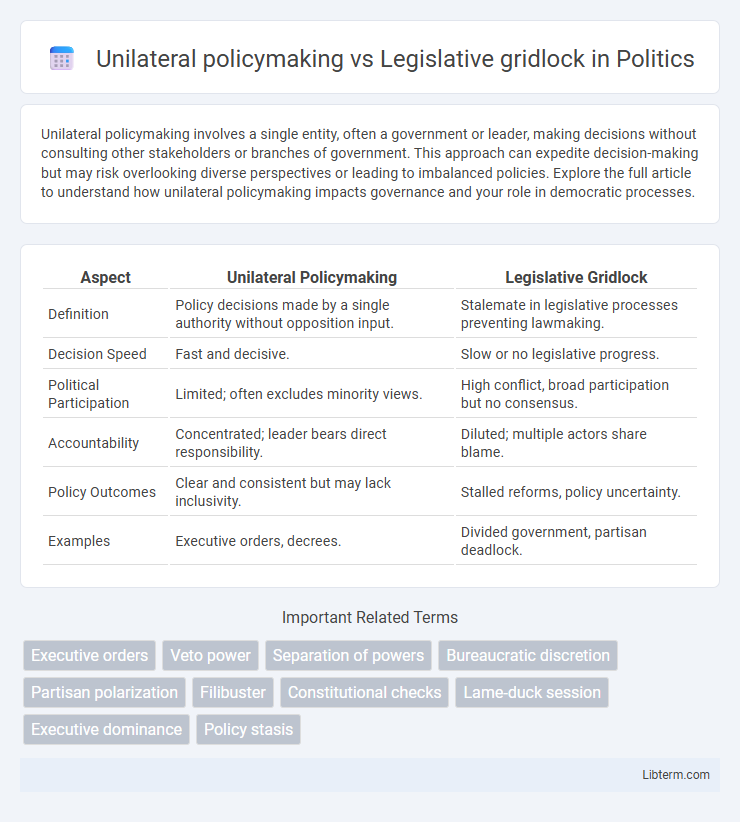Unilateral policymaking involves a single entity, often a government or leader, making decisions without consulting other stakeholders or branches of government. This approach can expedite decision-making but may risk overlooking diverse perspectives or leading to imbalanced policies. Explore the full article to understand how unilateral policymaking impacts governance and your role in democratic processes.
Table of Comparison
| Aspect | Unilateral Policymaking | Legislative Gridlock |
|---|---|---|
| Definition | Policy decisions made by a single authority without opposition input. | Stalemate in legislative processes preventing lawmaking. |
| Decision Speed | Fast and decisive. | Slow or no legislative progress. |
| Political Participation | Limited; often excludes minority views. | High conflict, broad participation but no consensus. |
| Accountability | Concentrated; leader bears direct responsibility. | Diluted; multiple actors share blame. |
| Policy Outcomes | Clear and consistent but may lack inclusivity. | Stalled reforms, policy uncertainty. |
| Examples | Executive orders, decrees. | Divided government, partisan deadlock. |
Understanding Unilateral Policymaking
Unilateral policymaking enables executive leaders to implement priorities swiftly by bypassing prolonged legislative debates and gridlock often caused by partisan divisions in Congress. This approach leverages executive orders, memoranda, and administrative actions to address pressing issues efficiently without requiring legislative approval, which can be especially critical during emergencies or urgent policy shifts. However, reliance on unilateral decisions can provoke political backlash and legal challenges, highlighting the delicate balance between swift governance and democratic processes.
Defining Legislative Gridlock
Legislative gridlock occurs when political parties or branches of government are unable to reach consensus, resulting in stalled or blocked legislation. This impasse often contrasts with unilateral policymaking, where executive authorities bypass legislative bodies to enact policies independently. Understanding legislative gridlock highlights the challenges of democratic governance and the trade-offs between collaboration and efficiency in lawmaking.
Historical Context: Executive Action vs. Congressional Stalemate
The historical context of unilateral policymaking highlights the executive branch's increasing reliance on executive orders and emergency powers to bypass legislative gridlock in Congress. Legislative gridlock often emerges from deep partisan divisions and procedural hurdles within the House and Senate, preventing timely passage of key policies. Notable examples include the New Deal era expansions under Franklin D. Roosevelt's executive initiatives and the frequent use of executive orders in recent administrations to advance policy amid congressional stalemate.
Causes of Legislative Inaction
Legislative gridlock often stems from deep political polarization, where opposing parties hold divergent policy goals and resist compromise, leading to legislative inaction. Unilateral policymaking emerges as a strategic response when executive leaders bypass the legislature to implement policies directly, especially during periods of congressional stalemate. Institutional factors such as divided government, procedural rules like the filibuster, and partisan conflicts exacerbate obstacles to passing legislation, intensifying legislative paralysis.
The Appeal of Unilateral Presidential Power
Unilateral presidential power appeals as a solution to legislative gridlock by enabling decisive action without reliance on congressional consensus. This approach allows the executive branch to implement policies swiftly through executive orders and administrative directives, bypassing stalled legislative processes. However, reliance on unilateral actions risks undermining democratic checks and balances, raising concerns about the concentration of power within the presidency.
Democratic Accountability and Checks on Power
Unilateral policymaking enables executives to act swiftly without prolonged legislative approval, enhancing responsiveness but potentially undermining democratic accountability by concentrating power in a single branch. Legislative gridlock reflects a system of checks on power through divided government or partisan conflict, preserving democratic deliberation but often resulting in policy stagnation and inefficiency. Balancing these dynamics is crucial to ensuring effective governance while maintaining robust democratic oversight and preventing executive overreach.
Policy Outcomes: Speed vs. Deliberation
Unilateral policymaking accelerates policy implementation by enabling swift executive action, often bypassing prolonged legislative debates. Legislative gridlock, characterized by partisan stalemates, slows policy outcomes but encourages thorough deliberation and consensus-building among diverse stakeholders. The trade-off between speed and deliberation influences the effectiveness and public acceptance of policies in dynamic political environments.
Risks and Consequences of Governing Alone
Unilateral policymaking risks undermining democratic processes by sidestepping legislative input, leading to diminished checks and balances. This approach often intensifies political polarization, exacerbating legislative gridlock as opposition parties resist executive overreach. Consequences include reduced policy stability, increased legal challenges, and erosion of public trust in governance institutions.
Case Studies: Notable Instances of Both Approaches
Case studies of unilateral policymaking reveal significant examples such as the use of executive orders by U.S. presidents like Franklin D. Roosevelt's New Deal policies and Barack Obama's Deferred Action for Childhood Arrivals (DACA), demonstrating rapid agenda-setting without legislative approval. In contrast, legislative gridlock is exemplified by the U.S. government shutdowns in 2013 and 2018-2019, where partisan divisions in Congress prevented budget approvals and stalled policymaking. These instances highlight the strategic trade-offs between bypassing legislatures for swift action and the stalemates caused by entrenched political conflicts in bicameral systems.
Balancing Efficiency and Representation in Policymaking
Unilateral policymaking enables swift decision-making by concentrating authority in the executive branch, increasing efficiency in addressing urgent issues but potentially sacrificing broad representation. Legislative gridlock occurs when partisan divides stall policy enactment, reflecting diverse interests but causing inefficiency and delayed governance. Balancing efficiency and representation demands institutional designs that encourage collaboration while preserving mechanisms for minority input, ensuring policies are both timely and democratically legitimate.
Unilateral policymaking Infographic

 libterm.com
libterm.com